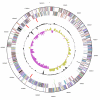Complete genome sequence of Thermanaerovibrio acidaminovorans type strain (Su883)
- PMID: 21304665
- PMCID: PMC3035242
- DOI: 10.4056/sigs.40645
Complete genome sequence of Thermanaerovibrio acidaminovorans type strain (Su883)
Abstract
Thermanaerovibrio acidaminovorans (Guangsheng et al. 1997) Baena et al. 1999 is the type species of the genus Thermanaerovibrio and is of phylogenetic interest because of the very isolated location of the novel phylum Synergistetes. T. acidaminovorans Su883(T) is a Gram-negative, motile, non-spore-forming bacterium isolated from an anaerobic reactor of a sugar refinery in The Netherlands. Here we describe the features of this organism, together with the complete genome sequence, and annotation. This is the first completed genome sequence from a member of the phylum Synergistetes. The 1,848,474 bp long single replicon genome with its 1765 protein-coding and 60 RNA genes is part of the Genomic Encyclopedia of Bacteria and Archaea project.
Keywords: Synergistales; Synergistetes; amino acid fermentation; co-culture with Methanobacterium thermoautotrophicum; lithotrophic; oxidative decarboxylation; strictly anaerobic; thermophile.
Figures



References
-
- Baena S, Fardeau ML, Woo TH, Ollivier B, Labat M, Patel BK. Phylogenetic relationships of three amino-acid-utilizing anaerobes, Selenomonas acidaminovorans, 'Selenomonas acidaminophila' and Eubacterium acidaminophilum, as inferred from partial 16S rDNA nucleotide sequences and proposal of Thermanaerovibrio acidaminovorans gen. nov., comb. nov. and Anaeromusa acidaminophila gen. nov., comb. nov. Int J Syst Bacteriol 1999; 49:969-974 - PubMed
-
- Guangsheng C, Plugge CM, Roelofsen W, Houwen FP, Stams AJM. Selenomonas acidaminovorans sp. nov., a versatile thermophilic proton-reducing anaerobe able to grow by decarboxylation of succinate to propionate. Arch Microbiol 1992; 157:169-175
LinkOut - more resources
Full Text Sources
Other Literature Sources
Molecular Biology Databases

